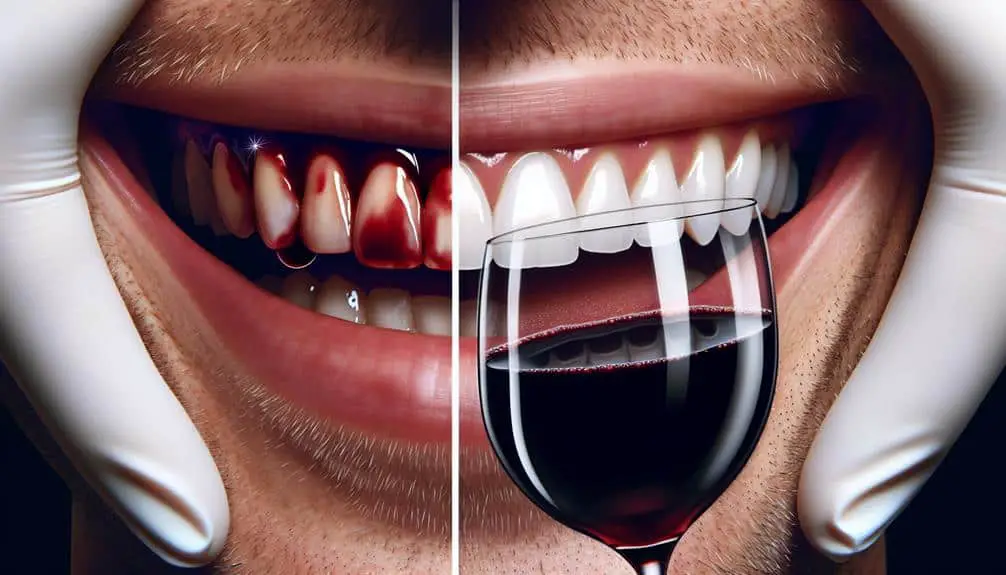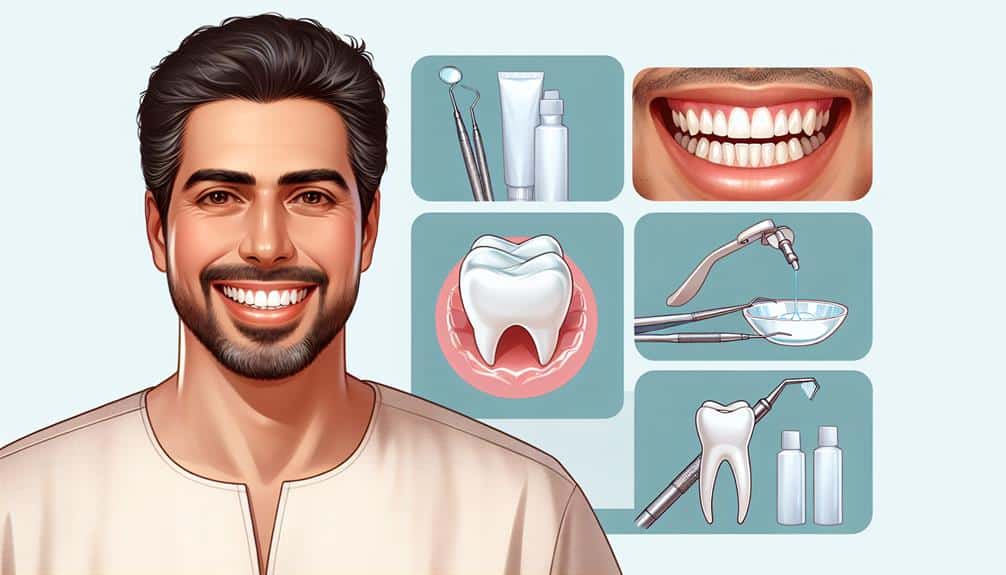To remove wine stains from your teeth, focus on prevention. Brush with fluoride toothpaste regularly and floss daily. Try using a straw to limit wine contact with your teeth. After indulging, rinse with water. Natural remedies like sage or baking soda can help. Consider professional whitening treatments for stubborn stains. Maintain stain-free teeth by brushing, flossing, and watching your diet. Drinking water after stain-causing items is key. More advice awaits for a sparkling smile!
Key Points
- Brush teeth after wine to prevent immediate staining.
- Use whitening toothpaste to combat wine discoloration.
- Rinse mouth with water to minimize wine residue.
- Consider professional whitening treatments for stubborn stains.
- Adopt oral hygiene practices to prevent future wine stains.
Causes of Wine Stains on Teeth
If you enjoy indulging in red wine, you may have noticed the staining it can cause on your teeth. This teeth discoloration occurs due to the impact of red wine's chromogens, acidic nature, and tannins.
Chromogens are deeply pigmented molecules that adhere to the enamel of your teeth, causing them to take on a darker hue. The acidity of red wine also plays a role in teeth staining by weakening the enamel, making it more susceptible to picking up pigments. Additionally, tannins, naturally occurring compounds in red wine, help chromogens bind to the teeth, intensifying the staining effect.
Understanding these factors can help you appreciate why red wine is particularly notorious for causing teeth discoloration. The combination of chromogens, acidity, and tannins makes red wine a potent culprit in staining teeth. By being mindful of these properties, you can take proactive steps to minimize the impact of red wine on your teeth and maintain a brighter smile.
Prevention Methods for Wine Stains
To prevent wine stains on your teeth, implementing proactive oral care practices is essential. Here are four preventive techniques and oral health strategies to keep your teeth looking their best:
- Regular Brushing: Brush your teeth at least twice a day with a fluoride toothpaste to remove surface stains and prevent them from setting in. Pay special attention to areas where stains tend to accumulate, such as along the gumline.
- Floss Daily: Flossing helps remove plaque and debris between teeth that your toothbrush may miss. This can prevent the buildup of substances that lead to staining.
- Use a Straw: When enjoying wine, use a straw to minimize direct contact between the wine and your teeth. This can help reduce the amount of staining agents that come into contact with your enamel.
- Rinse with Water: After consuming wine, rinse your mouth with water to help wash away staining compounds and reduce their impact on your teeth. This simple step can make a significant difference in preventing wine stains.
Natural Remedies for Wine Stains
To naturally combat wine stains on your teeth, explore effective remedies that can help restore your smile's brightness and prevent future discoloration.
Herbal solutions provide a gentle yet potent way to address wine stains. For example, using a mixture of sage and sea salt as a natural toothpaste can help scrub away surface stains. Another herbal option is applying a paste made of baking soda and hydrogen peroxide to gently whiten teeth.
DIY options also offer practical solutions for removing wine stains. Oil pulling with coconut or sesame oil can help remove toxins and stains from the teeth, promoting overall oral health. Additionally, rubbing the inside of a banana peel on your teeth for a few minutes can help lift surface stains due to its natural minerals.
These natural remedies can be effective in combating wine stains while being gentle on your teeth, providing a more sustainable approach to maintaining a bright smile.
Professional Whitening Treatments
Professional whitening treatments performed by dental professionals offer a highly effective solution for removing stubborn wine stains from teeth and achieving a brighter smile. If you're considering this option, here are some key points to keep in mind:
- Laser Treatment: Dental offices often provide laser treatments for whitening teeth. This method is quick and efficient, targeting deep-set stains effectively.
- Bleaching: Another common professional whitening method is bleaching, which helps break down stains and discoloration caused by wine consumption.
- In-Office Procedures: Opting for in-office whitening procedures guarantees that the treatment is administered by trained professionals, offering a more controlled and potent solution.
- At-Home Maintenance: After undergoing professional whitening treatments, maintaining your results at home is essential. Dentists may provide at-home whitening kits to help you preserve the whiteness of your teeth between visits.
Maintenance Tips for Stain-Free Teeth
If you want to maintain your bright smile post-professional whitening treatments, incorporating effective maintenance tips for stain-free teeth is essential. Daily routines play an important role in keeping your teeth free from stains. Make sure to brush your teeth at least twice a day with a fluoride toothpaste to remove surface stains and prevent plaque buildup. Flossing daily is equally vital as it helps remove food particles and plaque from between your teeth where your toothbrush may not reach.
In addition to daily oral hygiene practices, making dietary changes can also help in maintaining stain-free teeth. Limiting your consumption of stain-causing foods and beverages such as coffee, tea, red wine, and dark berries can prevent new stains from forming. When you do consume these items, consider drinking water afterwards to help wash away any pigments that could potentially stain your teeth.
Frequently Asked Questions
Can Brushing Your Teeth Immediately After Drinking Wine Help Prevent Stains?
After savoring wine, resist the urge to brush immediately. Let the enamel rest. Then, use a gentle toothpaste and mouthwash. Seek advice from dental professionals for best care. Prevention is key.
Are There Specific Types of Wine That Are More Likely to Cause Stains on Teeth?
When it comes to teeth discoloration, some wine varietals are more likely to cause stains. Red wines, especially those with deep colors like Malbec or Cabernet Sauvignon, have higher staining potential due to their tannins.
Can Using a Straw While Drinking Wine Help Prevent Staining on Teeth?
Using a straw while sipping wine can be a clever way to minimize teeth staining. By directing the liquid past your teeth, you're helping to reduce potential discoloration. Pair this with regular flossing for best oral health.
Are There Any Foods That Can Help Reduce the Likelihood of Wine Stains on Teeth?
To help prevent wine stains on your teeth, consider food choices that can provide natural protection. Foods like apples, carrots, and celery can help reduce the likelihood of stains by naturally scrubbing your teeth and promoting saliva production.
How Long Does It Typically Take for Wine Stains to Develop on Teeth After Consuming Wine?
After wine consumption, stain development on teeth usually begins within hours. The discoloration process varies based on factors like enamel health and wine type. Regular oral care can help minimize the timing of wine stain formation.



